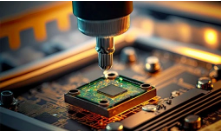UMC and Avalanche Technology partner for MRAM development and 28nm production
United Microelectronics Corporation (NYSE: UMC; TWSE: 2303) (“UMC”), a global semiconductor foundry, and Avalanche Technology, Inc., the next generation STT-MRAM (Spin Transfer Torque Magnetic RAM) leader, today announced that they have entered a partnership for joint development and production of MRAM to replace embedded flash. UMC will also make this technology available to other companies through licensing with Avalanche Technology Inc.
Under the terms of the agreement, UMC will provide embedded non-volatile MRAM blocks based on UMC’s 28nm CMOS manufacturing process. This will enable customers to integrate low latency, very high performance and low power embedded MRAM memory blocks into MCUs and SoCs, targeting the Internet of Things, wearable, consumer, industrial and automotive electronics markets.
The two companies are also considering to expand the cooperation beyond 28nm, as Avalanche Technology’s CMOS compatibility and scalability to advanced process nodes enables integration of unified memory (non-volatile as well as SRAM) blocks into next generation highly integrated MCUs and SoCs. This allows system designers to maintain the same architecture and software ecosystem without a redesign.
“We’re excited to team with a world leader in semiconductor manufacturing such as UMC to bring this outstanding technology to market,” said Petro Estakhri, CEO and co-founder of Avalanche Technology.
“UMC is continuously introducing enhanced process offerings to bring added competitive benefits to our customers,” said G C Hung, vice president of Advanced Technology Development at UMC. “With embedded NVM becoming more prevalent in today’s IC designs, we have developed a strong portfolio of robust eNVM process solutions for high growth sectors such as emerging consumer and automotive applications. We are happy to cooperate with Avalanche Technology for 28nm MRAM, and we look forward to ramping this process to production for UMC customers.”
在线留言询价

UMC Halts R&D Project with China Chipmaker
- 一周热料
- 紧缺物料秒杀
| 型号 | 品牌 | 询价 |
|---|---|---|
| CDZVT2R20B | ROHM Semiconductor | |
| TL431ACLPR | Texas Instruments | |
| RB751G-40T2R | ROHM Semiconductor | |
| MC33074DR2G | onsemi | |
| BD71847AMWV-E2 | ROHM Semiconductor |
| 型号 | 品牌 | 抢购 |
|---|---|---|
| STM32F429IGT6 | STMicroelectronics | |
| TPS63050YFFR | Texas Instruments | |
| ESR03EZPJ151 | ROHM Semiconductor | |
| BU33JA2MNVX-CTL | ROHM Semiconductor | |
| BP3621 | ROHM Semiconductor | |
| IPZ40N04S5L4R8ATMA1 | Infineon Technologies |
- 周排行榜
- 月排行榜
AMEYA360公众号二维码
识别二维码,即可关注


请输入下方图片中的验证码:
























